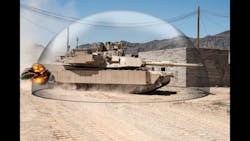Army relies on radar, counter-fire, and signal processing for active protection in armored combat vehicles
The MIL & AERO COMMENTARY – Active protection for armored combat vehicles -- or the ability to destroy incoming anti-tank weapons before they hit -- is on the verge of widespread deployment, as combat vehicle manufacturers start to consider active protection to be an essential part of modern design.
General Dynamics Land Systems in Sterling Heights, Mich., designer of the M1A2 Abrams main battle tank, took one of the latest moves toward active vehicle protection last month when the Army awarded the company a $280.1 million order to procure kits for the Trophy expedited active protection system aboard M1A2 Abrams SEPv2 and SEPv3 tanks.
This action is part of a long string of U.S. military developments to integrate radar and computer processors into new and upgraded armored combat vehicles to enable these battlefield behemoths to defend themselves from rocket-propelled grenades, anti-tank guided missiles, and similar threats.
Quick-reaction active-protection systems use radar and potentially other kinds of sensors to detect incoming anti-tank weapons, and fire counter-weapons fast enough to destroy or deflect them before the anti-tank weapons can do serious damage.
These systems must be lightning-fast to detect and react to incoming threats in milliseconds. It takes the fastest computer processors possible, software that works in real time, and counter-munitions placed around the combat vehicle to get a clear shot at incoming threats.
General Dynamics relies on the Leonardo DRS Land Systems segment in St. Louis to provide the Trophy active-protection system for the Abrams tank. DRS is adapting technology developed by Rafael Advanced Defense Systems Ltd. in Haifa, Israel, to help shield Abrams tanks from anti-armor weapons.
DRS and Rafael are adapting the Rafael Trophy active protection system to the M1A2 Abrams tank. Rafael developed Trophy together with the Elta Group of Israel Aerospace Industries Ltd. in Ashdod, Israel. The Trophy system intercepts and destroys incoming missiles and rockets with a shotgun-like blast.
Trophy vetronics is designed to locate and destroy incoming enemy fire instantly using a 360-degree radar, processor, and on-board computer. It can locate, track, and destroy approaching anti-tank-guided-missiles, rocket-propelled grenades, or similar anti-armor weapons by launching a countermeasure to detonate the incoming munition away from the vehicle.
The interceptor uses small shaped charges attached to a gimbal on top of the vehicle. The small explosives fire to a point in space to intercept and destroy the approaching round. Trophy locates and identifies incoming threats with radar that scans the tank’s perimeter out to a known range. The on-board computer determines the optimal kill point for any incoming threat.
Trophy has been used in combat on Israeli Merkava tanks. In addition to locating and destroying incoming missiles and rocket-propelled grenades, the system also can locate and cue weapons to the positions enemy shooters.
The DRS-Rafael Trophy system can defeat known anti-armor shaped-charge weapons, like missiles, rockets, and tank-fired high-explosive anti-tank shells before they strike the tank.
The system enables networked threat awareness by pinpointing and reporting shooter location improves platform protection with low risk of collateral injury, and can ensure freedom of movement and maneuver, DRS officials say.
Today the focus of active protection for armored vehicles is on relatively light infantry weapons like rocket-propelled grenades. It's no clear how enabling technologies for active protection may evolve to counter larger anti-armor weapons like the tube-launched, optically tracked, wire-guided (TOW) missile, aircraft- and helicopter-launched anti-tank weapons, or future hypersonic battlefield weapons.
It all comes down to what military systems designers have wanted to decades: faster computer processing, small size, weight, and power consumption (SWaP) components, and advanced radar small enough for battlefield vehicles.

John Keller | Editor-in-Chief
John Keller is the Editor-in-Chief, Military & Aerospace Electronics Magazine--provides extensive coverage and analysis of enabling electronics and optoelectronic technologies in military, space and commercial aviation applications. John has been a member of the Military & Aerospace Electronics staff since 1989 and chief editor since 1995.

